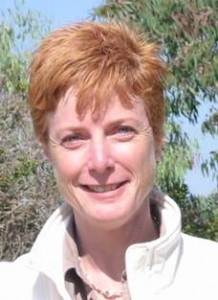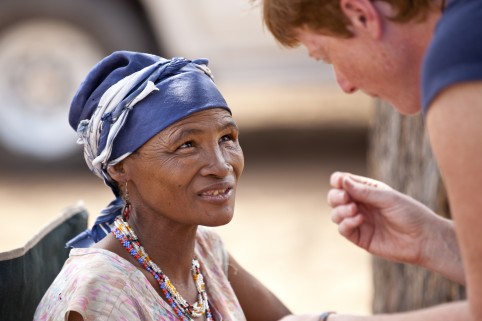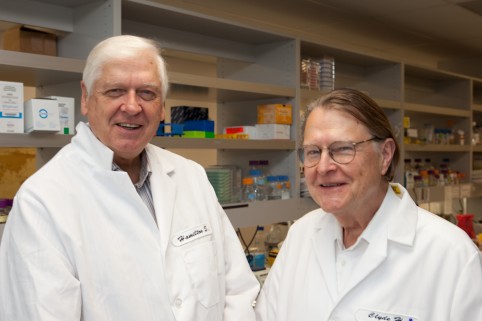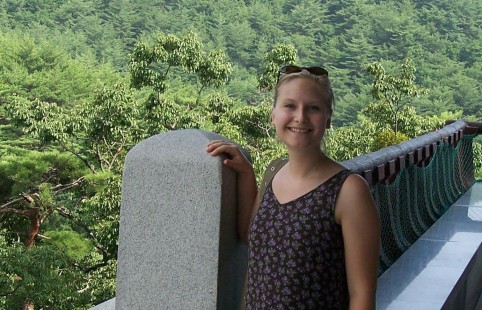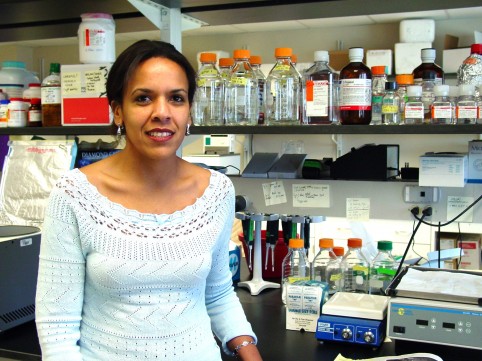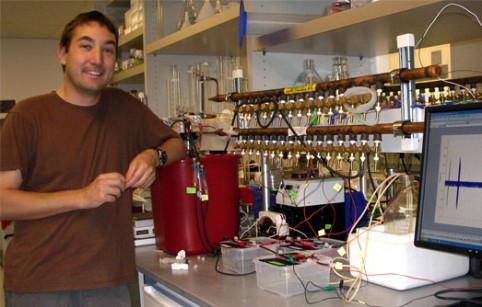As the J. Craig Venter Institute (JCVI) soars into its 19th year, we reflect on the past year of highlights and accomplishments to mark the close 2010 and look forward to more significant scientific advances in 2011.
JCVI Top 10 of 2010 …
1. First Synthetic Cell: Fifteen years in the making, 2010 brought to bear with huge anticipation the successful construction of the first self-replicating, synthetic bacterial cell. The work was published in Science in May. The synthetic cell called Mycoplasma mycoides JCVI-syn1.0 is the proof of principle that genomes can be designed in the computer, chemically made in the laboratory and transplanted into a recipient cell to produce a new self-replicating cell controlled only by an artificial genome. Although the first synthetic cell was not designed to produce a specific bioproduct, the team has shown that this can be done and the potential benefits are numerous. The research team, lead by JCVI President Craig Venter, Hamilton Smith, Clyde Hutchison, and Daniel Gibson, envision a future where the rapid design and production of biological products using synthetic biology techniques will be used to produce clean fuels, medicines, and other bioproducts. Throughout the course of this work, the JCVI Policy group has extensively engaged in outside review of the ethical and societal implications of this work, including advising the new Presidential Commission on Bioethics on their recommendations for oversight.
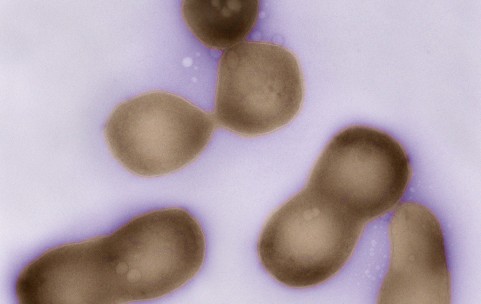
M. mycoides JCVI-syn1
2. Synthetic Vaccines: Following on the heels of the announcement of the first synthetic cell, the company Synthetic Genomics Inc. and JCVI announced in October the formation of a new company, Synthetic Genomics Vaccines Inc. (SGVI). The privately held company is focused on developing next generation vaccines that can be rapidly produced and tested, which is especially important for outbreaks of new infectious diseases. SGVI also announced a three-year collaboration with Novartis to apply synthetic genomics technologies to accelerate the production of the influenza (flu) seed strains required for vaccine manufacturing. The seed strain is the starter culture of a virus, and is the base from which larger quantities of the vaccine virus can be grown. Under this collaboration, Novartis and SGVI will work to develop a “bank” of synthetically constructed seed viruses ready to go into production as soon as WHO makes recommendations on the flu strains. The technology could reduce vaccine production time by up to two months, which is particularly critical in the event of a pandemic.
3. Hydra Genome – one of the animal kingdom’s earliest common ancestors: JCVI scientists along with more than 70 other researchers from around the world, have sequenced and analyzed the genome of Hydra magnipapillata, a fresh water member of the cnidaria- stinging animals that include jellyfish, sea anemones and corals. The research, published in the March 14 edition of Nature, was co-led by Ewen F. Kirkness, JCVI, Jarrod A. Chapman, Department of Energy Joint Genome Institute, and Oleg Simakov, University of California, Berkeley. This is the second sequenced cnidarian genome, following that of a sea anemone, Nematostella vectensis, in 2007. The ancestors of these two species diverged more than 500 million years ago, and comparison of their genomes has revealed common features of the earliest animals that gave rise to the diversity of animals on Earth today. The team found clear evidence for conserved genome structure between the Hydra and other animals, like humans. Unexpectedly, the sequencing also revealed a novel bacterium that lives in close association with the Hydra.
4. Uncovering the Human Microbiome: Microbes are living within and on the human body and this collective community is called the human microbiome. JCVI Scientists, as one component of the large scale NIH Roadmap Human Microbiome Project, and along with colleagues at three other genome centers sequenced the genomes of ~180 microbes from the human body, published in the May 21 edition of Science. At the JCVI we anticipate sequencing an additional 400 species over the next few months. Colleagues at the JCVI are also using single cell approaches to isolate new strains that have not been cultured – isolates whose genomes will also be completely sequenced. The role these microbes play in human health and disease is still relatively unknown and these approaches are allowing us to gain a greater understanding of these enigmatic species.
5. Body Louse Genome: A global research team led by Ewen Kirkness and colleagues from JCVI published a study in the Proceedings of the National Academy of Sciences in June describing the sequencing and analysis of the human body louse, Pediculus humanus humanus, a human parasite responsible for the transmission of bacteria that cause epidemic typhus, relapsing fever and trench fever. Detailed analysis of the genome was then conducted by a large international group of 71 scientists, coordinated by Barry Pittendrigh, University of Illinois, and Professor Evgeny Zdobnov, University of Geneva Medical School. Comparative studies of the body louse genome with other species revealed features that will enhance our understanding of the relationships between disease-vector insects, the pathogens they transmit, and the human hosts. In addition to the targeted louse genome, the project unexpectedly yielded the complete genome sequence of a bacterial species, Riesia, that lives in close association with lice, and which is essential for survival of the insects. The researchers believe that the genome will be a valuable reference for evolutionary studies of insect species, especially in the areas related to insect growth and development.
6. Castor Bean Genome Sequencing: A research team co-led by Agnes P. Chan and colleagues from JCVI and Jonathan Crabtree and others at the Institute for Genome Sciences, University of Maryland School of Medicine, published the sequence and analysis of the castor bean (Ricinus communis) genome in Nature Biotechnology in August. Because of the potential use of castor bean as a biofuel and its production of the potent toxin ricin, the team focused efforts on analysis of genes related to oil and ricin production. The analyses could be important for comparative studies with other oilseed crops, and could also allow for genetic engineering of castor bean to produce oil without ricin. Identifying and understanding the ricin–producing gene family in castor bean will be important in preventing and dealing with potential bioterrorism events. Genomics enables enhanced diagnostic and forensic methods for the detection of ricin and precise identification of strains and geographical origins. As a next step, the group suggests further comparative genomic studies with the close relative cassava, a major crop in the developing world, to further elucidate their disease resistance aspects.
7. Science Education: JCVI was an Official Partner of the inaugural USA Science and Engineering Festival held on the National Mall in Washington, DC in October. The Festival, which was the country’s first national science festival, included over 500 of the country’s leading science and engineering organizations with the aim to reignite the interest of our nation’s youth in the sciences. The JCVI ‘Discover Genomes’ Bus was showcased during a two-day expo and some of the research being done at JCVI was presented to around 1700 visitors by our scientists and staff.
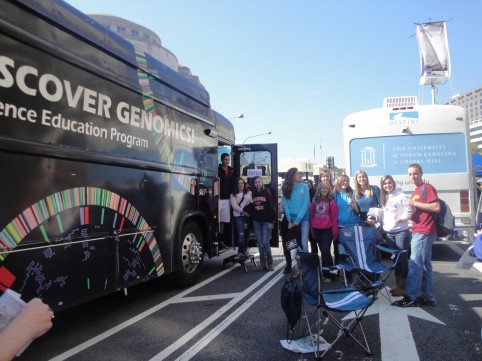
There were lines all day!
8. Viral Genomics– In 2010 the JCVI has published over 1600 influenza genomes and over 75% of all published flu genomes to date have been sequenced by the JCVI, totaling over 6000 genomes. This year the diversity of viral genomes we have sequenced has significantly expanded under the NIH Genomic Sequencing Center for Infectious Diseases contract. Some of the projects include viruses causing diseases such as measles, mumps, rubella, encephalitis, SARS, and the common cold, just to name a few. The viral group has annotated and published 79 Rotavirus (stomach flu) and 33 Coronavirus genomes (includes SARS and common cold) this year and many more will be published in 2011. The pace of sequencing and finishing genomes has also increased this year as a result of adoption of nextgen platforms (e.g. Illumina/454 and Illumina/Solexa) and the development of more efficient methodologies to increase productivity while reducing costs.
9. Marine Microbial Genome Sequencing Project: JCVI scientists have continued their quest to isolate and sequencing microbes living in global ocean waters to discover new genes and enzymes, and to help understand the role microbes play in the ocean ecosystem. Shibu Yooseph, Kenneth Nealson and colleagues at JCVI published an analysis of 137 known marine microbial genomes living in the global ocean surface in Nature in November. These genomes were compared to metagenomic samples of ocean waters of 10.97 million sequences of JCVI’s Sorcerer II Global Ocean Sampling (GOS) metagenomic data and thousands of 16S rRNA sequences. The marine genomes were collected as part of the Gordon and Betty Moore Foundation-funded Marine Microbial Genome Sequencing Project, a project coordinated by JCVI that has a primary goal of obtaining whole genome sequences of ecologically important microbes from a variety of diverse, global marine environments. The work provides a good example of combining metagenomic data with sequenced genomes data to study microbial communities and to generate testable hypotheses in microbial ecology.
10. Sorcerer II Global Ocean Sampling Expedition: On December 17th 2010 Sorcerer II arrived in Florida after spending the last two years with her crew collecting samples in The Baltic, Mediterranean and Black Seas. Funded generously by the Beyster Family Foundation Fund, The San Diego Foundation, and Life Technologies Foundation, Sorcerer II has sailed ~28,000 nautical miles since departing San Diego in March 2009. During this time 212 samples were collected and over 5,100 liters of sea water was filtered and sent to JCVI for analysis of the microbial life contained within these samples. The JCVI established strong collaborations with scientists in all 16 countries in which samples were collected, which will lead to joint publications and future collaborative studies in the new year. Read more.
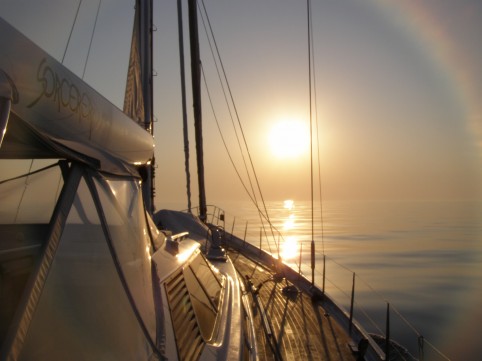
Sunrise in the Ligurian Sea
Looking Forward to 2011…
Ten-year anniversary of the Human Genome Project: To commemorate the anniversary of the publications of the first human genome sequences in 2001, JCVI and Nature are hosting a conference and celebration in February 2011 titled - Human Genomics: The Next 10 Years. The conference will look forward to the promises of human genomics for the next 10 years, with sessions on medical advances related to genomics; the technological and ethical challenges of human genomics; personalized and familial genomics; the human microbiome project; variation in the human genome; and making sense of the genetic code. This conference will be a great way to jump into the new year and inspire the grandiose ideas and achievements that genomic scientists will accomplish over the years to come.




